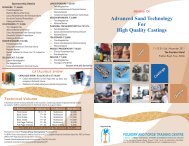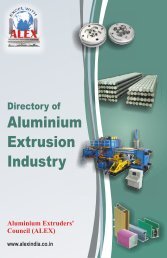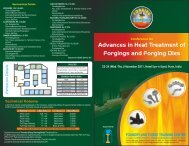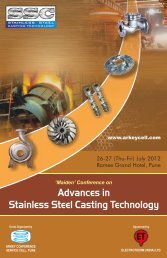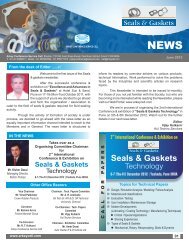LWT - Arkey Group
LWT - Arkey Group
LWT - Arkey Group
Create successful ePaper yourself
Turn your PDF publications into a flip-book with our unique Google optimized e-Paper software.
Current usage of Aluminium in car<br />
than 50% less than a standard steel version. The carbon<br />
Today's car contain 140 Kg OF ALUMINIUM<br />
bonnet is a sandwich construction comprising a foam core<br />
material between two layers of carbon fibre reinforced<br />
The Audi A8L, the Jaguar XJ and the Range Rover are well plastic and was developed as part of the High-tech NRW<br />
known for their high aluminium content, exceeding 500 kg, but research project.<br />
all cars actually contain significant amounts of aluminium .<br />
5. Automotive supplier Faurecia signed a framework<br />
A study published by Ducker worldwide in cooperation with the agreement with German research institute Fraunhofer<br />
European aluminium association shows that the amount of ICT concerning the joint R&D of industrial processes for<br />
aluminium used per car produced in Europe almost tripled composites for automotive applications .<br />
between 1990 and 2012, increasing from 50 kg to140 kg. This<br />
6. Carbon fibre manufacturer Teijin announced the start up<br />
amount is predicted to rise to 160 kg by 2020, and even reach<br />
of its pilot plant in Japan for carbon fibre thermoplastic<br />
as much as 180 kg if small and medium cars follow the<br />
automotive parts. This uses Teijin's proprietary<br />
evolution recorded in the upper segments of the automobile<br />
manufacturing technology which is reported to reduce<br />
industry.<br />
cycle times required for moulding composite parts to less<br />
The study is based on a detailed analysis of car models than 1 minute. In December 2011, Teijn and General<br />
representing a European production volume of 17 million units Motors (GM) announced plans to co-develop carbon fibre<br />
in 2012. The distribution of the140 kg on various parts can be composite technologies for potential use in high-volume<br />
seen.<br />
GM vehicles.<br />
Source - European Aluminum Association<br />
Carbon composites and cars – technology<br />
watch 2012<br />
2012 saw numerous developments and collaborations in the<br />
automotive composites sector. Some of them are :<br />
1. I Ford and Dow Automotive Systems signed a joint<br />
development agreement to research the use of carbon<br />
fibre composites in high-volume vehicles. Cutting the<br />
weight of new cars by up to 750 lbs by the end of the<br />
Automotive high strength steels<br />
Steel, and in particular AHSS, best addresses the need for<br />
reduced GHG emissions without compromising safety and<br />
afford ability and not the low-density materials, like aluminium,<br />
magnesium and plastics.<br />
Collective findings of the research organized by world auto<br />
steel show that replacing former conventional steel designs<br />
with optimized advanced high-strength steel designs will, on<br />
average, gain:<br />
decade is key to Ford's strategy to improve fuel efficiency. • 21 to 25% reduction in body-in-white weight,<br />
A couple of months later Dow announced plans to form a<br />
• 9% reduction in vehicle weight,<br />
joint venture with Turkish company AKSA to manufacture<br />
• 5.1% reduced fuel consumption,<br />
carbon fibre.<br />
• 5.7% reduced life cycle GHG emissions (CO2 equivalent)<br />
2. Benteler-SGL & Co KG, a joint venture between<br />
and,<br />
automotive supplier Benteler Automobiltechnik GmbH<br />
• Little or no increase in manufacturing costs.<br />
and carbon fibre manufacturer SGL <strong>Group</strong>, announced an<br />
investment of €36 million in a new plant in Austria to If optimised advanced high-strength steel body-in-white<br />
manufacture automotive components made of carbon applications are replaced with aluminium applications, the<br />
composites. The plant will start series production in mid replacement will, on average, gain:<br />
2013.<br />
• Only an 11% further reduction in body-in-white weight,3%<br />
3. Showing that glass fibre is still very much in the mix, in July further reduction in vehicle weight,<br />
SABIC Innovative Plastics announced that it was<br />
"Significantly Boosting" capacity for its STAMAX long<br />
• 1.8% further reduction of fuel consumption,<br />
glass fibre reinforced polypropylene composite to meet • 2.6% increased life cycle GHG emissions (CO2 equivalent)<br />
growing demand from automotive customers. The new and 65% increased production costs for body-in white.<br />
production line is scheduled to start up in the second half<br />
of 2013. STAMAX is used in front-end modules, door<br />
modules, and seating and tailgate structures.<br />
4. Ford announced it had developed a prototype carbon fibre<br />
composite bonnet for the Ford Focus which weighs more<br />
www.arkeycell.com 3



